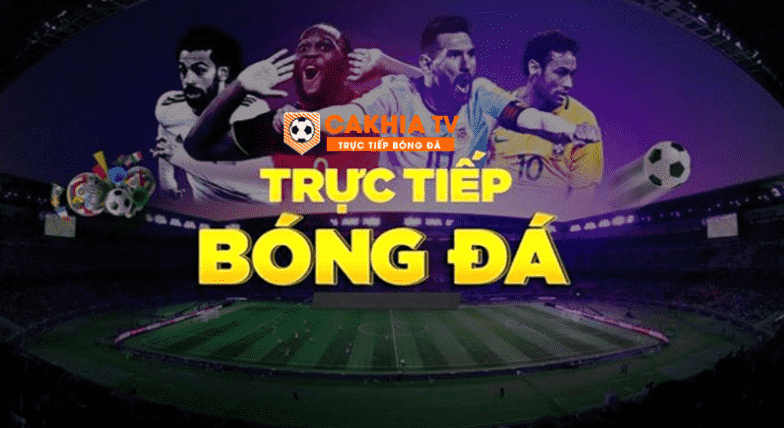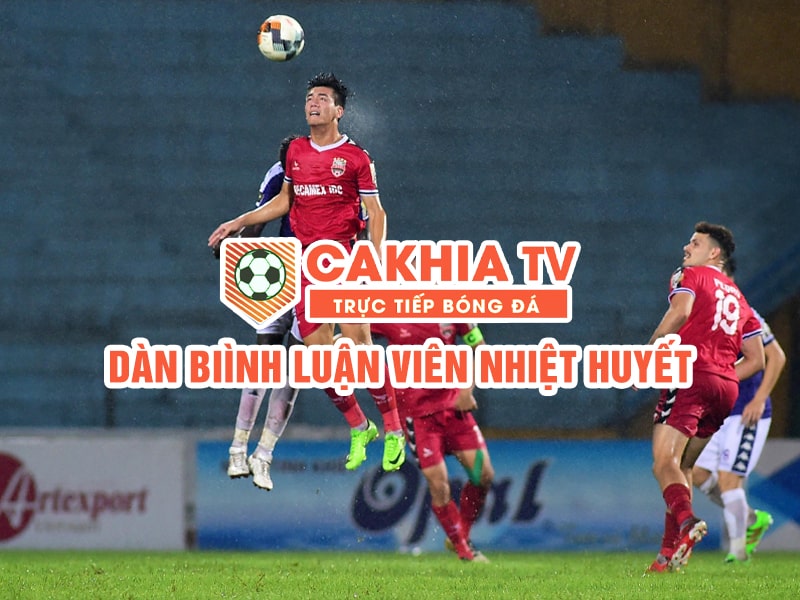CakhiaTV – Thiên đường trực tiếp bóng đá – Xem bóng đá Cakhia hấp dẫn
Cakhia TV là một kênh trực tiếp bóng đá nổi tiếng được đông đảo anh em lựa chọn. Mặc dù trên thị trường hiện nay số lượng các trang web phát sóng bóng đá không hề nhỏ. Tuy nhiên Cà Khịa TV vẫn được xem là một trong những “cái tên” nổi tiếng và nhận được sự lựa chọn của đông đảo mọi người. Để hiểu rõ hơn về kênh trực tiếp bóng đá này, hãy cùng theo dõi bài viết dưới đây nhé!

CakhiaTV là gì?
Có thể bạn vẫn thắc mắc Cakhia TV là gì và vẫn chưa biết rõ về trang web này. Đây chính là một trang web được xây dựng bởi đội ngũ nhân viên hùng nhậu với sự đầu tư lớn nhằm phát sóng, tường thuật những trận đấu lớn nhỏ với chất lượng vượt trội, mượt mà dành cho quý anh em.
Ngay từ ngày đầu thành lập, Cakhia. link đã nhanh chóng gây nên một cơn sốt trên thị trường. Bởi vì đây là một địa chỉ xem bóng đá cực mượt mà và chất lượng. Số lượng người theo dõi đang ngày càng tăng cao và hiện nay vẫn không ngừng tăng lên mỗi ngày.
Đến với CakhiaTV bạn có thể theo dõi bất kỳ trận bóng đá nào mà mình yêu thích. Kể cả những trận đấu không được tường thuật trên K+ hay những hệ thống trang web khác thì đều được trực tiếp bóng đá Cà Khịa. Nhờ đó mà quý anh em có thể thỏa mãn niềm đam mê bóng đá của mình.
Chúng tôi không “ngủ quên trên chiến thắng” mà vẫn đang cố gắng, nỗ lực và phấn đấu từng ngày. Cà Khịa TV luôn dành sự đầu tư lớn cả về tiền bạc, công sức lẫn thời gian để áp dụng những công nghệ tiên tiến, hiện đại và tối tân nhất vào hệ thống trang web của mình để quý anh em có thể theo dõi những trận cầu nảy lửa nhất.
Ưu điểm khi lựa chọn CakhiaTV

Chỉ mới ra đời và hoạt động một thời gian ngắn nhưng Cakhia TV đã nhanh chóng trở thành một đơn vị tên tuổi trong các trang web phát sóng bóng đá. Để giúp bạn tự tin hơn khi lựa chọn kênh xem bóng đá trực tuyến này, hãy điểm qua những điểm mạnh của trực tiếp bóng đá Cakhia 20 như sau:
Có sự đầu tư lớn về website
Điều đầu tiên tạo nên sự ấn tượng đối với mọi người đó chính là giao diện đẹp mắt của Cakhia TV. Trang web được thiết kế khá đơn giản với gam màu nhẹ nhàng và tinh tế. Nhờ đó mà khi bạn truy cập vào đây sẽ cảm nhận được sự khác biệt hẳn hỏi so với những trang web khác.
CakhiaTV hiểu rằng, để theo dõi một trận đấu cần mất một khoảng thời gian tối thiểu là 90 phút và có thể kéo dài hơn rất nhiều. Nhưng khi nhìn vào màn hình máy tính hoặc điện thoại quá lâu sẽ dẫn đến tình trạng bị mỏi, nhức mắt.
Do đó mà chúng tôi đã lựa chọn những tông màu nhẹ nhàng, không quá sặc sỡ. Để khi theo dõi trận đấu bạn sẽ cảm thấy thoải mái, dễ chịu và có thể tận hưởng những giây phút cực cháy cùng những trận cầu nảy lửa.
Ngoài ra, nhằm giúp cho mọi người dễ dàng hơn trong việc lựa chọn được trận đấu mà mình mong muốn. Cakhia TV trực tiếp bóng đá hôm nay được thiết kế với giao diện dễ nhìn, khoa học và thông minh.
Thông thường bạn chỉ cần mất một vài giây để tìm kiếm được trận cầu mà mình đang mong muốn. Những nút bấm của trang web sẽ được thiết kế bởi tông màu riêng, tạo điểm nhấn ấn tượng. Đồng thời các nút bấm cũng được bố trí khoa học để người xem có thể thực hiện thao tác dễ dàng và nhanh chóng nhất.
Trực tiếp các trận đấu lớn nhỏ trên toàn Thế Giới
Mỗi ngày tại Cakhia 20 TV sẽ cập nhật liên tục những trận đấu hấp dẫn. Những trận bóng thuộc giải đấu lớn hay nhỏ đều được phát sóng trực tiếp tại trang web của chúng tôi. Do đó mà anh em có thể dễ dàng theo dõi và tận hưởng không khí nhiệt huyết của bóng đá.

Bạn có thể theo dõi những giải đấu hàng đầu hiện nay như:
- Giải World Cup
- Giải Ngoại Hạng Anh
- Giải Euro
- Giải Champion League
- Giải Bundesliga
- Giải La Liga
- Giải Europa League
- Giải Ligue 1
- Giải Serie A
- Giải V – League
Không chỉ dừng lại ở đó, tại Cakhia 17 bạn có thể theo dõi vô vàn những trận cầu từ các giải đấu trong nước và những khu vực, quốc gia khác trên thế giới.
Đến với trang web của chúng tôi bạn sẽ không cần lo ngại về vấn đề bị thiếu các trận cầu để theo dõi. Hàng ngày sẽ có rất nhiều các trận bóng được phát sóng trực tiếp để anh em xem và thưởng thức.
Anh em không mất tiền khi xem bóng đá
Có thể bạn chưa biết. Cakhia TV hoạt động với tiêu chí phi lợi nhuận. Điều này có nghĩa là bạn không phải trả tiền khi xem bóng đá tại trang web này. Đây chính là một trong những ưu điểm giúp cho kênh bóng đá này trở nên nổi tiếng và thu hút đến vậy.
Vì một số trang web khác bạn chỉ có thể xem được một số trận đấu mà thôi. Đối với những trận nổi tiếng, hấp dẫn và thú vị có thể bạn phải trả phí mới có thể theo dõi được. Do đó mà không ít anh em đã tin tưởng sử dụng Cakhia. link để theo dõi bóng đá được tốt hơn.
Mặc dù phát sóng miễn phí nhưng những trận đấu tại đây vẫn đảm bảo về mặt chất lượng. Bởi vì Cakhia TV trực tiếp bóng đá hôm nay đã mua bản quyền đầy đủ từ các giải đấu. Cà Khịa TV đã chi ra một số tiền khổng lồ để mua bản quyền từ những giải đấu lớn nhỏ hiện nay.
Để có được một hệ thống trang web phát sóng trực tiếp bóng Cakhia chất lượng. Chúng tôi sẽ duy trì những hoạt động của mình thông qua việc thu phí từ các nhà cái bóng đá đặt banner quảng cáo trên trang web. Bên cạnh đó, số lượng người tham gia theo dõi bóng đá càng nhiều thì số tiền mà Cakhia TV thu được càng lớn. Nhờ đó mà chúng tôi có thể cung cấp đến bạn một trang web xem bóng đá hoàn toàn miễn phí nhưng vẫn đảm bảo chất lượng.
Sức hấp dẫn và cuốn hút của trận đấu

Mặc dù hiện nay anh em có niềm đam mê lớn với bóng đá. Tuy nhiên một số người sẽ cảm thấy buồn, tẻ nhạt nếu chỉ xem bóng đá một mình. Do đó mà để tăng thêm sức hút, sự hấp dẫn cho các trận đấu, CakhiaTV đã xây dựng đội ngũ bình luận viên nổi tiếng hàng đầu Việt Nam trong lĩnh vực bóng đá.
Có thể kể đến một số cái tên nổi trội như: Leo Nát Đô, Batman, Giàng A Phò,.. Với lối nói chuyện duyên dáng, cuốn hút, hài hước những bình luận viên sẽ giúp bạn cảm thấy trận đấu vui nhộn, hấp dẫn và không còn tẻ nhạt.
Đặc biệt, những bình luận trong trận đấu hoàn toàn bằng tiếng việt. Điều này giúp cho anh em thuận tiện hơn trong việc theo dõi và cập nhật những thông tin của trận đấu.
Ngoài ra, bạn có thể để lại những bình luận hay trò chuyện cùng những người xem khác thông qua khung chat đã được Cakhia TV xây dựng. Với tính năng trò chuyện sẽ giúp bạn mở rộng mối quan hệ, tìm kiếm những người bạn mới có cùng đam mê với bản thân.
Xem trực tiếp bóng đá Cà Khịa liên tục, không bị gián đoạn bởi quảng cáo
Hiện nay vấn đề quảng cáo làm ngắt quãng video vẫn đang là vấn đề nhức nhối. Không ít người cảm thấy phiền phức và rắc rối khi theo dõi trận đấu hấp dẫn mà phải bị dừng lại bởi các đoạn quảng cáo.
Tuy nhiên, với Cakhia TV link thì đây sẽ không còn là nỗi lo đối với anh em. Vì chúng tôi không cho phép các đoạn quảng cáo chạy trong video trực tiếp bóng đá. Mà chỉ cho phép banner quảng cáo nhà cái ở giao diện chính mà thôi.
Nhờ đó mà quá trình xem trực tiếp bóng đá Cakhia sẽ được diễn ra liên tục, không bị gián đoạn. Giúp anh em có thể theo dõi được những pha bóng hấp dẫn, không bỏ lỡ bất kỳ diễn biến nào của trận đấu.
Đây được xem là một điểm cộng của Cakhia 20 TV được nhiều anh em phản hồi tích cực. Bạn có thể tham gia ngay vào thiên đường của các trận đấu và cảm nhận những điều hấp dẫn, tối ưu tại đây.
An toàn tuyệt đối khi lựa chọn CakhiaTV
Một vấn đề mà không ít anh em quan tâm khi xem trực tiếp bóng đá tại Cakhia 17 đó là có thực sự an toàn hay không. Không ít người lo ngại về vấn đề bị đánh cắp thông tin cá nhân. Hoặc xảy ra tình trạng virus xâm nhập vào thiết bị điện tử của bạn khiến cho dữ liệu bị đánh cặp, lộ ra bên ngoài.
Nhưng với hệ thống Cakhia TV trực tiếp bóng đá hôm nay thì vấn đề trên bạn không cần phải quá lo lắng. Chúng tôi đã xây dựng một hệ thống trang web bảo mật cao với sự hỗ trợ của những công nghệ hiện đại, tiên tiến. Nhờ đó mà thông tin, dữ liệu của bạn sẽ luôn được bảo vệ an toàn và không bao giờ bị đánh cắp.
Bên cạnh đó, vì đã được mua bản quyền từ các giải đấu lớn nên trong quá trình bạn xem bóng đá sẽ không rơi vào tình trạng bị giật lag. Đường truyền của Cà Khịa TV vô cùng ổn định, mượt mà và không có các sự cố nào khác. Tuy nhiên, bạn cần đảm bảo thiết bị của mình được kết nối internet ổn định để trong quá trình xem bóng đá không bị ngắt quãng giữa chừng.
Những tính năng hấp dẫn khác tại Cakhia TV
Ngoài sự chất lượng của Cakhia trực tiếp bóng đá hôm nay thì trang web này còn cung cấp đến người xem nhiều tính năng hữu ích và hiện đại khác, chẳng hạn như:
- Mỗi ngày, biên tập viên của Cakhia 20 link sẽ cập nhật các tin tức về bóng đá mới nhất để anh em theo dõi kịp thời.
- Lịch thi đấu sẽ được cập nhật nhanh chóng và trước khi trận đấu được diễn ra một khoảng thời gian nhất định. Điều này sẽ giúp cho anh em có thể sắp xếp được khung thời gian của mình để có thể theo dõi trận bóng nảy lửa và không bị bỏ lỡ bất kỳ trận cầu nào.
- Sau khi trận đấu kết thúc, Cakhia TV sẽ cập nhật kết quả, highlight bóng đá và những thông tin bên lề để anh em tiện theo dõi.
- Ngoài ra, tại đây sẽ tổng hợp những kèo bóng đá từ các nhà cái để anh em có thể thỏa mãn niềm đam mê giải trí của mình.
CakhiaTV có gì khác so với những website trực tiếp bóng đá khác?

Cùng điểm qua bảng so sánh giữa Cà Khịa TV và những web trực tiếp bóng đá khác được tổng hợp từ những người xem mang tính khách quan, chân thực như sau:
| Cà Khịa TV | Website khác | |
| Chi phí xem trực tiếp bóng đá | Không phát sinh bất kỳ khoản chi phí nào | Có thể mất phí |
| Độ an toàn | An toàn tuyệt đối | Chưa đảm bảo được an toàn đối với người xem.
Còn xảy ra tình trạng bị đánh cắp thông tin và dữ liệu bị đánh cắp |
| Chất lượng phát sóng | Chất lượng cao.
Tạo nên sự thoải mái cho anh em khi theo dõi các trận cầu hấp dẫn |
Vẫn còn tình trạng bị ngắt quãng, giật lag hoặc thậm chí bị dừng khi đang xem và không thể tiếp tục |
| Phạm vi phát sóng các trận đấu | CakhiaTV tường thuật trực tiếp các trận đấu lớn nhỏ hiện nay | Vẫn còn hạn chế, nhiều trận đấu không được phát sóng |
| Tính năng bổ sung | Xây dựng nhiều tính năng bổ sung hữu ích phục vụ nhu cầu giải trí của anh em | Chưa có nhiều tính năng bổ sung |
Lưu ý khi xem trực tiếp bóng đá Cakhia TV
Để có những trải nghiệm tốt nhất khi xem bóng đá tại CakhiaTV bạn nên bỏ túi một số điều cần lưu ý như sau:
- Bạn cần chọn mạng internet có đường truyền cao, tốc độ ổn định. Bởi vì đường truyền của bạn cũng là một trong những nguyên nhân khiến cho quá trình xem bóng đá của bạn bị ảnh hưởng.
- Bạn nên truy cập vào đường link Cakhia 20 TV sớm để tránh tình trạng nhiều người cùng truy cập nên phải load lại.
- Mặc dù tại Cakhia 17 bạn có thể theo dõi trận đấu mượt mà, ổn định. Tuy nhiên vì số lượng người xem khá lớn nên có thể đôi lúc sẽ bị dừng lại. Lúc này, bạn chỉ cần bấm dừng lại khoảng 30 giây và tiếp tục theo dõi trận đấu là được.
- Nếu trong trường hợp đường link quá tải, bạn có thể truy cập vào CakhiaTV link, Cakhia 20, Cakhia 17, Cakhia 20 link hay cakhia. link. Đây đều là những trang web chính của Cà Khịa TV và bạn có thể theo dõi trực tiếp bóng đá tại đây.
Lời kết
Như vậy, anh em đã hiểu rõ hơn về CakhiaTV và biết được những ưu điểm nổi bật của kênh tường thuật bóng đá này. Anh em có thể truy cập vào đường link của Cakhia TV để theo dõi mỗi trận đấu nảy lửa. Nếu có bất kỳ trục trặc hay thắc mắc nào hãy liên hệ đến chúng tôi để được giải đáp, hỗ trợ. Chúng tôi luôn mong muốn mang đến cho mọi người một kênh phát sóng trực tiếp bóng đá hàng đầu Việt Nam. Tạo nên sự chất lượng, uy tín và đẳng cấp hiện nay.
